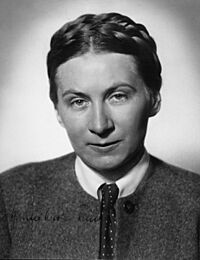Gertrud Scholtz-Klink facts for kids
Quick facts for kids
Gertrud Scholtz-Klink
|
|
|---|---|

Gertrud Scholtz-Klink, 1934
|
|
| Born |
Gertrud Emma Treusch
9 February 1902 |
| Died | 24 March 1999 (aged 97) |
| Known for | Leader of the National Socialist Women's League |
|
Notable work
|
Die Frau im Dritten Reich (The Woman in the Third Reich, 1978) |
| Political party | National Socialist German Workers' Party (NSDAP) |
| Spouse(s) | Eugen Klink (1920–1930) Günther Scholtz (1932–1938) August Heissmeyer (1940–1979) |
| Children | 6, including Ernst Klink |
Gertrud Emma Scholtz-Klink, born Treusch, was a key figure in Nazi Germany. She was born on February 9, 1902, and passed away on March 24, 1999. She became known as the leader of the National Socialist Women's League (NS-Frauenschaft). This group was the official women's organization of the Nazi Party.
Contents
Gertrud Scholtz-Klink's Role in Nazi Germany
Gertrud Scholtz-Klink joined the Nazi Party early on. By 1929, she was leading the women's section in the German region of Baden. She was married three times and had six children.
Becoming a Leader for Women
When Adolf Hitler came to power in 1933, he chose Scholtz-Klink for an important role. She became the Reich's Women's Führerin. This made her the top leader for women in Nazi Germany. She also became the head of the National Socialist Women's League.
Scholtz-Klink was a strong speaker. Her main job was to promote the Nazi ideas about women's roles. She often spoke about men being superior and how important it was for women to focus on home duties. She also stressed the importance of having many children.
What Were Her Main Messages?
In her speeches, Scholtz-Klink often said that a woman's main purpose was to care for the home and family. She believed women should support men throughout their lives. She argued that women should not be involved in politics. She saw female politicians from the earlier Weimar Republic as a bad example.
She claimed that if a woman entered politics, she would have to act like a man to succeed. Scholtz-Klink believed this would "shame her sex." If a woman acted like a woman in politics, she would not achieve anything. So, in her view, women should not be politicians at all.
Working for the Nazi Government

In July 1936, Scholtz-Klink was given another important job. She became the head of the Woman's Bureau in the German Labour Front. Her task was to convince women to work for the Nazi government's goals. She said that German women must work hard, both physically and mentally. She also said they should give up luxury and fun.
Even though she held high positions, Scholtz-Klink was often left out of the most important meetings. Nazi society was mostly run by men. She was seen more as a public figurehead. For propaganda reasons, Nazi Germany liked to show her as powerful to other countries. However, her opinions were not always considered important. Still, she had a lot of influence over women within the Nazi Party.
By 1940, she was married to her third husband, August Heissmeyer. He was a high-ranking officer in the SS. Scholtz-Klink often visited women in political concentration camps.
Life After World War II
At the end of World War II in Europe, Gertrud Scholtz-Klink and her husband fled from the Battle of Berlin. After Nazi Germany fell, she was briefly held in a Soviet prisoner camp. But she managed to escape soon after.
With help from Princess Pauline, she and her husband went into hiding. They lived under false names, Heinrich and Maria Stuckebrock, for three years. In 1948, they were found and arrested.
Scholtz-Klink faced legal consequences for her actions. She was put in prison for a period of time. After her release in 1953, she returned to live in Bebenhausen.
In 1978, she wrote a book called Die Frau im Dritten Reich (The Woman in the Third Reich). In this book, she continued to show her support for Nazi ideas. She also confirmed her views on Nazism in an interview in the early 1980s.
Gertrud Scholtz-Klink died on March 24, 1999, in Bebenhausen, Germany.
Images for kids
-
Scholtz-Klink (center) talking with Heinrich Himmler (left) in 1943.





